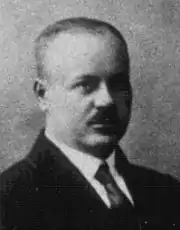Eugeniusz Budzyński
Eugeniusz Budzyński [ˈɛuɡɛniuˈsz ˈbudzɨˈɲski] (14 January 1893 – 1940) was a Polish balneologist, neurologist, internist and major in the Polish Army. He was killed in the Katyn massacre.[1][2]
Eugeniusz Budzyński | |
|---|---|
 Eugeniusz Budzynski | |
| Born | 14 January 1893 Kobiela, Russian Empire (now Poland) |
| Died | April or May 1940 (aged 47) |
| Occupation(s) | Balneologist, neurologist, internist and major in the Polish Army |
| Children | Witold |
Biography
Son of Eugeniusz and Leokadia of the Łapinkiewicz family. He studied medicine at the University of Yuryev in Tartu and obtained his doctor's degree in 1917. During his studies he was a member of the "Polonia" organization and the "Lechicja" academic corporation.[3]
From 1922 to 1928, the head of the Railway Hospital in Wilno on the city district "Wilcza Łapa", he was also a doctor at the Sickness Fund. In 1924 he was awarded a doctorate in medicine at the University of Warsaw. Since 1928 he has been a spa doctor at the National Spa Institute in Busko-Zdrój. He published about the healing properties of mineral waters in Polish spas.[4] In 1929, near the Marconi sanatorium, Budzyński built a boarding house "Sanato".[5] Many famous people stayed there for treatment, including Ludwik Solski,[6] who dedicated one of his poems to the Budzyński family in 1932. In 1937 he was appointed a member of the State Council for Health Resorts by the Minister of Social Welfare.
After the outbreak of World War II, Budzynski became the commander of a field hospital. After the Soviet invasion of Poland on 17 September 1939, he was taken prisoner near Lwów and transported to the camp in Kozelsk. He was murdered in Katyn, his body was identified at the exhumation.[7][8][9]
Awards
- Silver Cross of the Order of Virtuti Militari (no. 14384) - collective, posthumous decoration of Polish soldiers murdered in Katyn and other unknown places of execution awarded by the President of the Republic of Poland in Exile Professor Stanisław Ostrowski (11 November 1976)
- September Campaign Cross - a collective posthumous commemoration of all victims of the Katyn massacre (1 January 1986)
References
- "Lista katyńska". Retrieved 21 July 2019.
- "KATYN 1940-2010,Wojewódzka Biblioteka Publiczna Im. Witolda Gombrowicza w Kielcach, p.39,40,43. ISBN 978 -83-60108-82-6" (PDF). Retrieved 21 July 2019.
- "Korporanci w mogiłach katyńskich". Retrieved 21 July 2019.
- "Szkiece o konspiracyjnej pracy służby zdrowia w Okręgu 'Jodła', Lekarz Wojskowy 4/2012, p.415". Retrieved 21 July 2019.
- "Historia Pensjonatu". Retrieved 21 July 2019.
- "Spacer po Parku Zdrojowym". 17 October 2012. Retrieved 21 July 2019.
- "KATYN 1940-2010,Wojewódzka Biblioteka Publiczna Im. Witolda Gombrowicza w Kielcach, p.39,40,43. ISBN 978 -83-60108-82-6" (PDF). Retrieved 21 July 2019.
- Jan Bohdan Gliński (1997). Słownik biograficzny lekarzy i farmaceutów – ofiar drugiej wojny światowej. Wydawnictwo Medyczne Urban & Partners. p. 43-44. ISBN 83-85842-22-5.
- Tarczyński Marek; Kiński Jan; Malanowska; Olech Helena; Ryżewski Wacław; Snitko-Rzeszut Janina; Żach Teresa (2000). Księga Cmentarna Polskiego Cmentarza Wojennego w Katyniu (PDF). Rada Ochrony Pamięci Walk i Męczeństwa. ISBN 83-905590-7-2. Archived from the original (PDF) on 1 December 2012. Retrieved 20 April 2016.